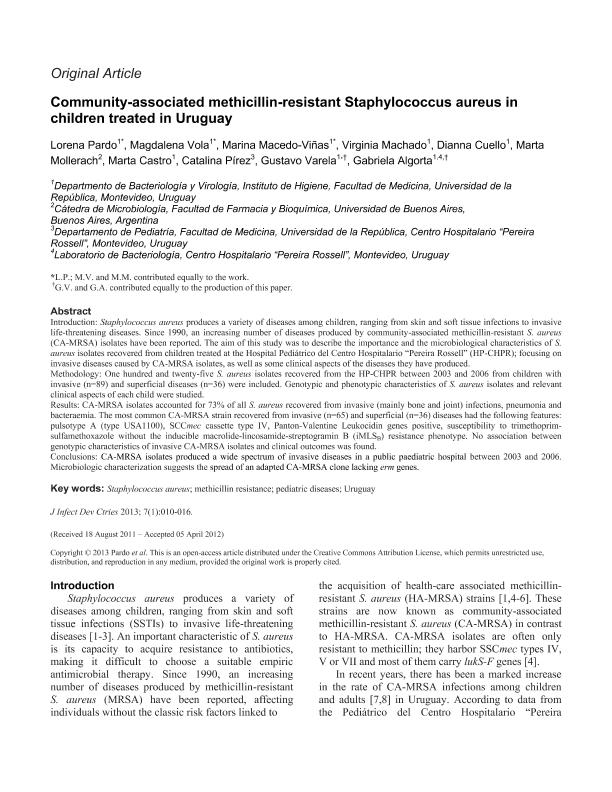Artículo
Community-associated methicillin-resistant Staphylococcus aureus in children treated in Uruguay
Pardo, Lorena; Vola, Magdalena; Macedo Viñas, Marina; Machado, Virginia; Cuello, Dianna; Mollerach, Marta Eugenia ; Castro, Marta; Pirez, Catalina; Varela, Gustavo; Algorta, Gabriela
; Castro, Marta; Pirez, Catalina; Varela, Gustavo; Algorta, Gabriela
 ; Castro, Marta; Pirez, Catalina; Varela, Gustavo; Algorta, Gabriela
; Castro, Marta; Pirez, Catalina; Varela, Gustavo; Algorta, Gabriela
Fecha de publicación:
01/2013
Editorial:
Porto Conte Ricerche Research Centre
Revista:
The Journal of Infection in Developing Countries
ISSN:
2036-6590
Idioma:
Inglés
Tipo de recurso:
Artículo publicado
Clasificación temática:
Resumen
Introduction: Staphylococcus aureus produces a variety of diseases among children, ranging from skin and soft tissue infections to invasive life-threatening diseases. Since 1990, an increasing number of diseases produced by community-associated methicillin-resistant S. aureus (CA-MRSA) isolates have been reported. The aim of this study was to describe the importance and the microbiological characteristics of S. aureus isolates recovered from children treated at the Hospital Pediátrico del Centro Hospitalario ?Pereira Rossell? (HP-CHPR); focusing on invasive diseases caused by CA-MRSA isolates, as well as some clinical aspects of the diseases they have produced. Methodology: One hundred and twenty-five S. aureus isolates recovered from the HP-CHPR between 2003 and 2006 from children with invasive (n=89) and superficial diseases (n=36) were included. Genotypic and phenotypic characteristics of S. aureus isolates and relevant clinical aspects of each child were studied. Results: CA-MRSA isolates accounted for 73% of all S. aureus recovered from invasive (mainly bone and joint) infections, pneumonia and bacteraemia. The most common CA-MRSA strain recovered from invasive (n=65) and superficial (n=36) diseases had the following features: pulsotype A (type USA1100), SCCmec cassette type IV, Panton-Valentine Leukocidin genes positive, susceptibility to trimethoprim-sulfamethoxazole without the inducible macrolide-lincosamide-streptogramin B (iMLSB) resistance phenotype. No association between genotypic characteristics of invasive CA-MRSA isolates and clinical outcomes was found. Conclusions: CA-MRSA isolates produced a wide spectrum of invasive diseases in a public paediatric hospital between 2003 and 2006. Microbiologic characterization suggests the spread of an adapted CA-MRSA clone lacking erm genes
Palabras clave:
Staphylococcus Aureus
,
Mrsa
Archivos asociados
Licencia
Identificadores
Colecciones
Articulos(OCA HOUSSAY)
Articulos de OFICINA DE COORDINACION ADMINISTRATIVA HOUSSAY
Articulos de OFICINA DE COORDINACION ADMINISTRATIVA HOUSSAY
Citación
Pardo, Lorena; Vola, Magdalena; Macedo Viñas, Marina; Machado, Virginia; Cuello, Dianna; et al.; Community-associated methicillin-resistant Staphylococcus aureus in children treated in Uruguay; Porto Conte Ricerche Research Centre; The Journal of Infection in Developing Countries; 7; 1; 1-2013; 10-16
Compartir



